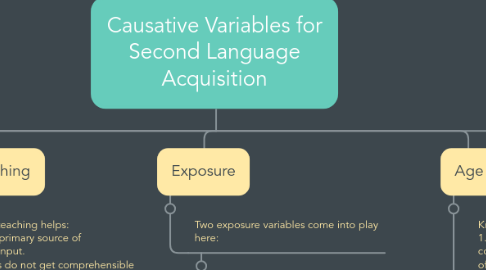
1. Language Teaching
1.1. When language teaching helps: 1. When it is the primary source of comprehensible input. 2. When students do not get comprehensible input outside the classroom (especially in foreign language contexts) 3. When students do not utilise English language outside of the classroom context, in their daily lives. (Krashen, Zelinski, Jones and Usprich, 1978)
1.2. When Language Teaching does not help: 1. When learners have been in a naturalistic environment, receiving comprehensible input from the environment (such as in the playground) for about 1-3 years, there is no significant difference in the level of proficiency for learners with or without ESL classes (Fathman, 1975) 2. In cases where learners have rich comprehensible input outside the classroom, teaching helps by equipping them to utilise this input fully.
2. Exposure
2.1. Two exposure variables come into play here:
2.1.1. 1. Length of Residence (LOR)- No definitive relationship could be found between length of residence and L2 proficiency. Spending extended periods of time in the L2 context does not result in more proficiency unless it is characterised by comprehensible input. 2. Use of the Second Language: Two out of three studies report a positive correlation between use and acquisition, because more "use" results in more comprehensible input. These studies involve adult subjects.
3. Age
3.1. Krashen, Long and Scarella (1979): 1. When as time and exposure is kept constant, adults go through early phases of language acquisition faster than young learners. 2. Under the same conditions, older children acquire language faster than younger children. 3. Children show higher proficiency only if they have been naturally exposed to L2 since childhood, in comparison to those who start as adults.
3.2. Significant monitor usage is possible only after a child has undergone the formal operational stage at puberty (Krashen, 1981), and this could also be the reason why adolescent learners who have been exposed to L2 since childhood show high proficiency levels- strengthening of the affective filter at puberty
4. Acculturation
4.1. Schuman (1978) hypothesizes that acculturation is a “major casual variable”. Type 1 Acculturation- learner is socially integrated with TL group so that any input he/she is exposed to becomes intake.
4.1.1. Social integration results in comprehensible input, while putting the learner at ease, which results in a psychologically open state which lowers the affective filter. Therefore, type one acculturation is essential for acquisition.
4.1.2. Schumann in reporting Heidelberg points out that learners whose work required communication with co-workers performed better, and learners who interacted more in the target language acquired it more.
